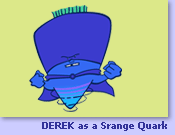

Semiconductor |
|
Materials that allow some electrons to move freely between atoms and molecules (e.g. silicon). |
Spin |
|
A property of particles that relates to how they move in the quantum world. Quarks have a half unit of spin that can be pointed so the quark is either spin up or a spin down. |
 |
Strange Quark |
One of the six types (flavors) of quarks. This particle has a negative charge and its mass is intermediate. Derek is shown here as a strange quark. |
 |
Strong Force |
One of the fundamental forces in nature. This force attracts particles that have the property of color. It is the force that binds quarks inside protons and neutrons (and other particles). It is also the force that holds protons and neutrons together in the nucleus of an atom. The carrier for the force is the gluon. |
